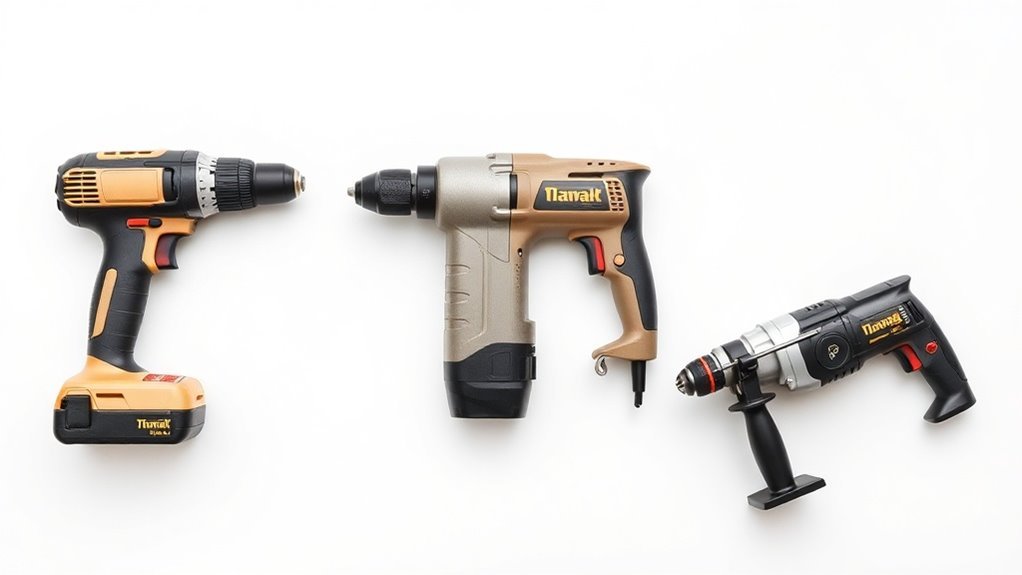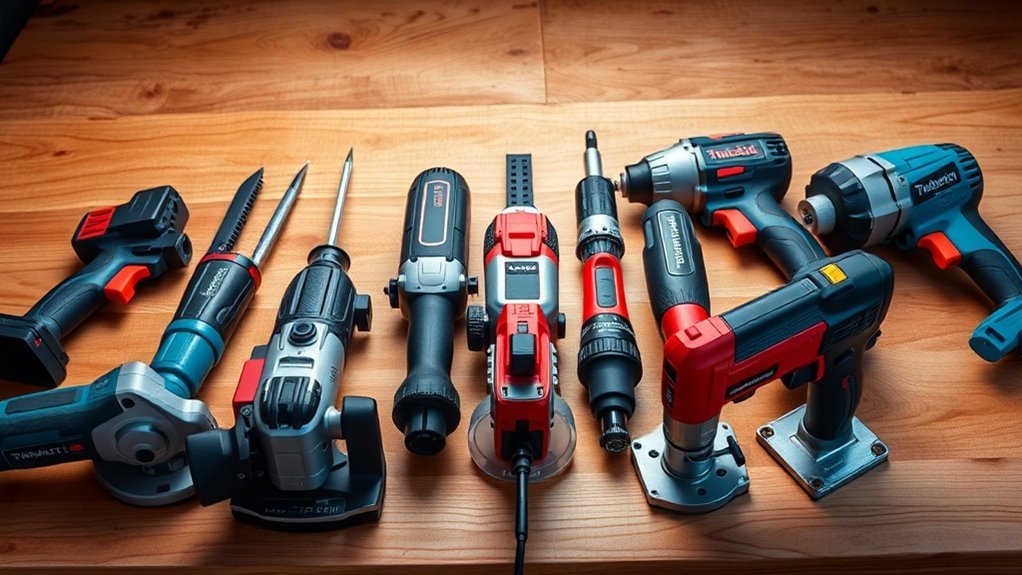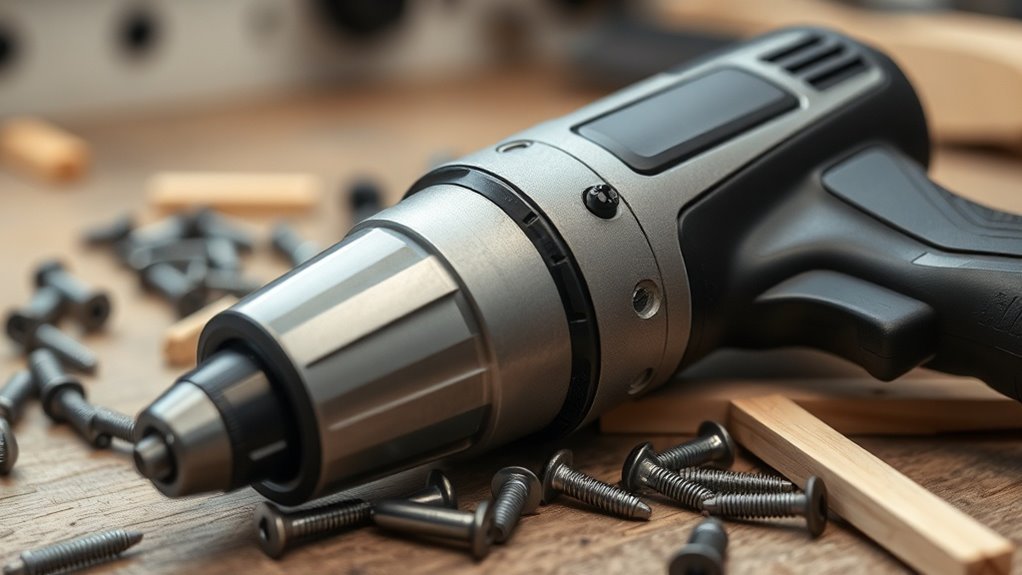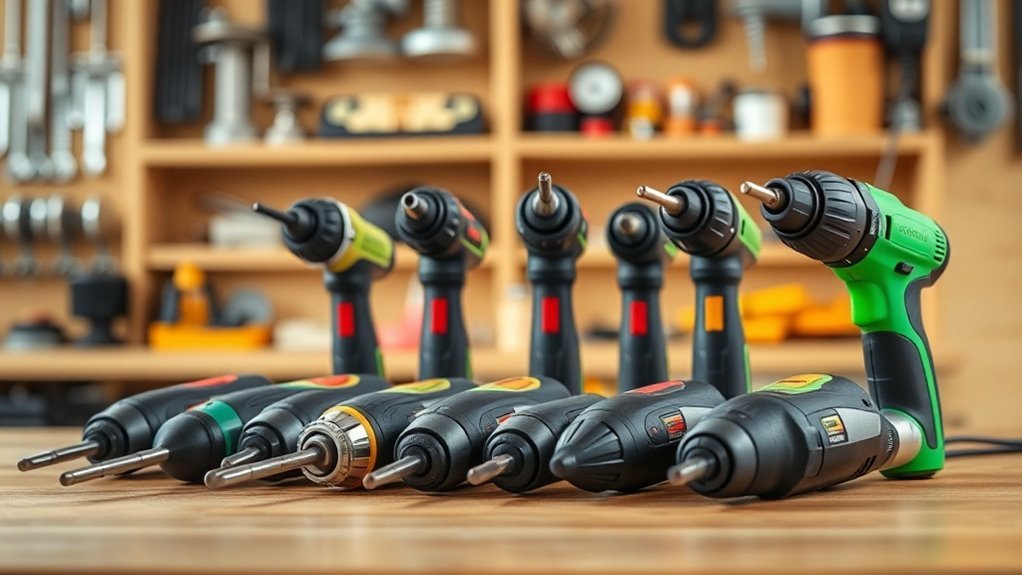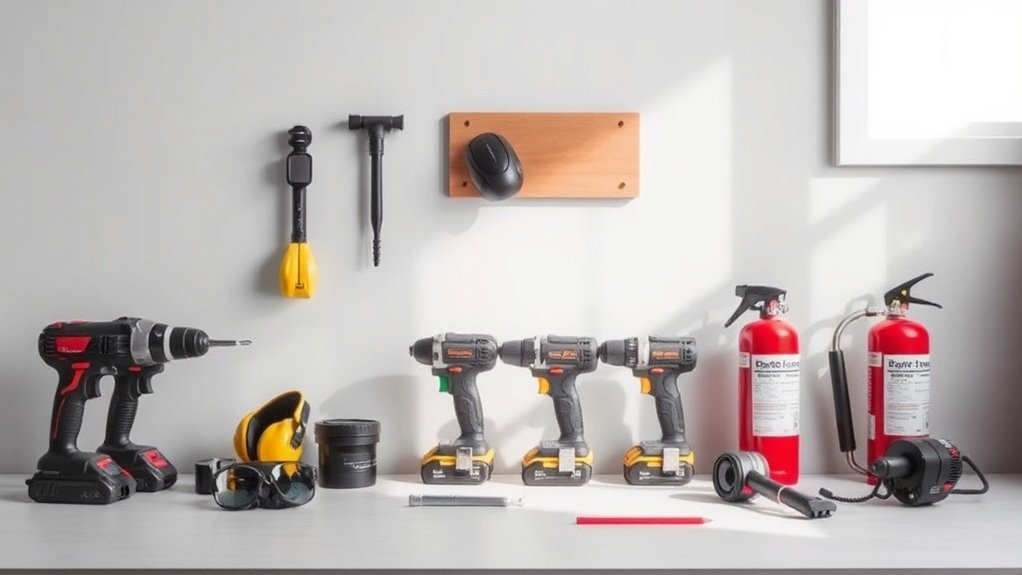Troubleshooting Common Power Tool Problems
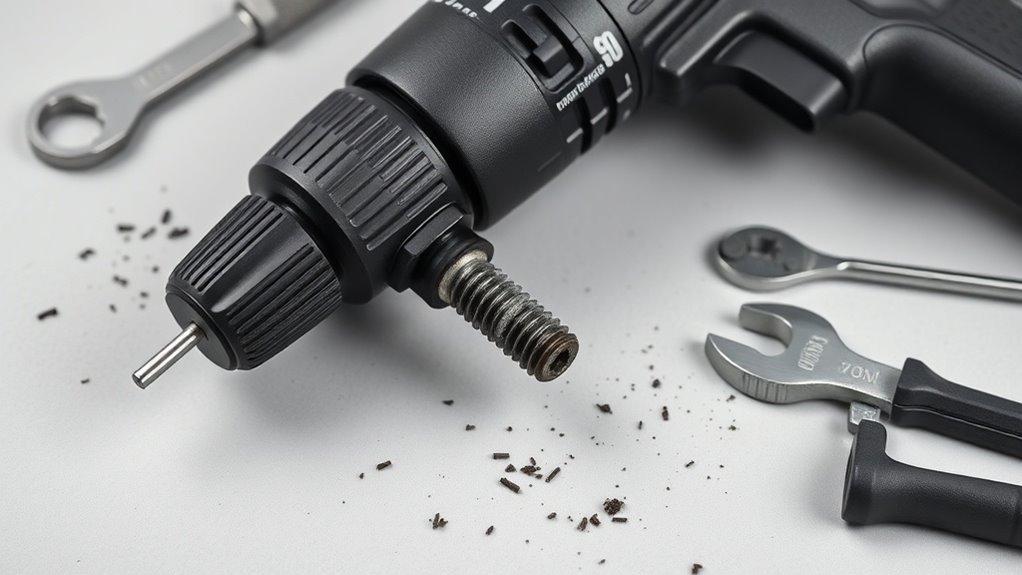
When troubleshooting common power tool problems, pay attention to unusual signs like odd noises or reduced performance. If your drill won’t start, check the power source; for circular saws with slow blade rotation, inspect the blade. Always disconnect power before checking. Overheating tools may need breaks for cooling. If issues persist, you might need professional help. Understanding these issues can help you maintain your tools better, and there’s more to discover to keep them running smoothly.
Key Takeaways
- Unplug tools before troubleshooting; inspect cords and switches for damage to ensure safety.
- For drills, check power sources and tighten chucks to avoid slipping bits.
- If circular saws show slow blade spinning, inspect blades for dullness or damage.
- Regularly assess cordless tool batteries and chargers to prevent charging issues and overheating.
- Seek professional help if you notice unusual noises, sparking, or persistent performance problems.
Identifying the Symptoms of Power Tool Issues
When you’re using power tools, it’s crucial to pay attention to any unusual signs that could indicate a problem.
Listen for odd noises, like grinding or rattling, which can signal mechanical issues. If the tool’s performance suddenly drops, like reduced speed or power, that’s another red flag.
Check for vibrations that feel inconsistent; these can indicate misalignment or damage. Additionally, watch for sparks or excessive heat—this could mean an electrical issue or wear and tear.
If you notice smoke or a burning smell, turn off the tool immediately. Finally, inspect any cords or switches for frays or damage.
Catching these symptoms early can often prevent more serious complications and keep you safe while working. Always remember to wear appropriate safety gear to protect yourself when troubleshooting any issues.
Common Drill Problems and Solutions
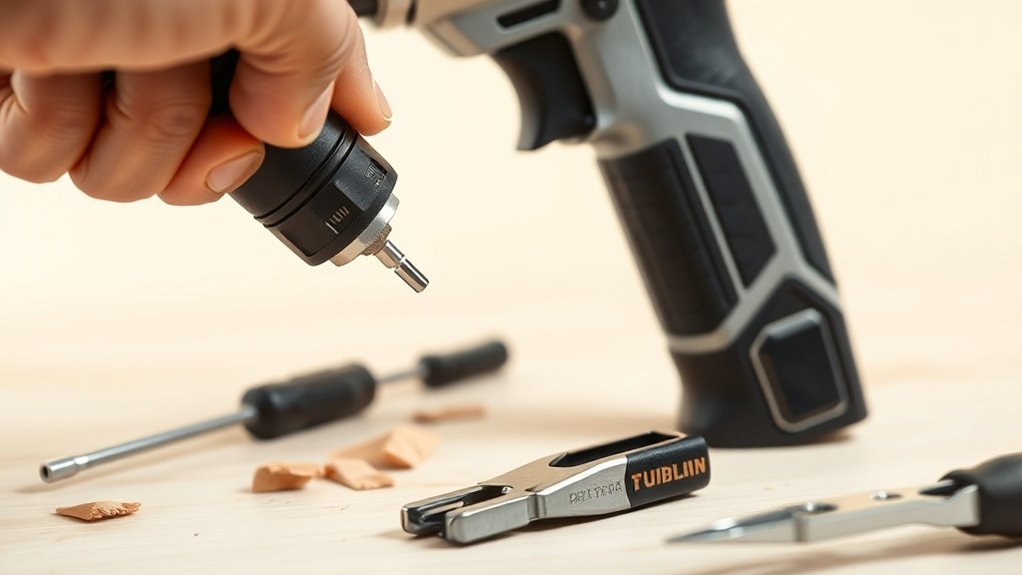
Drills are essential tools for any DIY project, but they can develop problems that may hinder your work.
Drills are vital for every DIY enthusiast, yet they can encounter issues that disrupt your projects.
Here are some common issues you might encounter and their solutions:
- Drill Won’t Start: Check the power source or battery. If it’s plugged in, confirm the outlet works.
- Bit Slips in Chuck: Tighten the chuck properly. If it’s damaged, consider replacing it.
- Overheating: Take breaks during heavy use and allow the drill to cool down. Clean any debris that might obstruct venting.
- Uneven Drilling: Make sure you’re applying consistent pressure and using the right speed setting for the material.
Understanding the specific type of drill you’re using, such as cordless drills, can also help in identifying and resolving these common problems efficiently.
Troubleshooting Circular Saws
While circular saws can make cutting tasks a breeze, they can also present challenges that disrupt your workflow.
If your saw’s not starting, check the power source, verifying it’s plugged in and the outlet’s functional. A tripped breaker could be the culprit too.
Is the blade spinning slowly? This could indicate a dull or damaged blade, so inspect it and replace if necessary.
If you’re experiencing excessive vibration, verify the blade’s properly tightened and aligned.
Another common issue is burning wood; this might mean you’re feeding the material too slowly or using a dull blade again.
Regular maintenance and blade inspections can minimize these problems, keeping your circular saw efficient and reliable throughout your projects. Additionally, proper cleaning techniques of your tools can help enhance their performance and longevity.
Dealing With Jigsaw Malfunctions
Jigsaws can be a handy tool for intricate cuts, but they can also run into problems that hinder your progress.
When your jigsaw starts acting up, it’s essential to identify the issue. Here are some common malfunctions you may encounter:
- Bla de Wobbles: A dull or damaged blade can cause uneven cuts or vibrations.
- Motor Overheating: Extended use without breaks can lead to overheating, risking damage.
- Power Issues: A faulty power cord or connection can result in an intermittent or complete loss of power.
- Base Plate Misalignment: If the base plate isn’t aligned correctly, it can affect accuracy and control.
Fixing Issues With Power Sanders
How can you keep your power sander running smoothly? First, make certain you’re using the correct sandpaper grit for your project; the wrong grit can cause excess wear and tear on the sander.
Check the sandpaper’s attachment to confirm it’s secure, as loose or incorrectly attached paper can lead to poor performance. If your sander isn’t running, inspect the power cord and plug for any damage.
Clean the dust collection system regularly to prevent overheating and improve efficiency. If you notice excessive vibrations, make sure all screws are tightened and check the sanding pad for wear.
Finally, lubricate moving parts as recommended in the manufacturer’s manual to keep everything functioning well. Additionally, consider the benefits of automatic shut-off systems, as they can further enhance the safety and longevity of your power sander.
Addressing Problems in Impact Wrenches
What do you do when your impact wrench isn’t performing as expected? First, don’t panic—there are common issues to check. Here are four steps you should take:
- Inspect the Power Source: Confirm it’s plugged in or charged. A weak battery can notably affect performance.
- Check the Socket and Bits: Make sure your attachments are compatible and securely fastened; an improper fit might cause slippage.
- Examine the Motor: Listen for unusual sounds. A grinding or rattling noise could indicate internal problems.
- Clean the Tool: Dust and debris build-up can hinder performance. Regular maintenance keeps everything running smoothly.
Additionally, understanding the mechanics of impact drivers and their mechanics can help in troubleshooting your tools more effectively.
Addressing these issues can often restore your impact wrench’s performance, so take these steps before considering a replacement.
Resolving Cordless Tool Battery Issues
When it comes to cordless tools, battery issues can be frustrating.
You might encounter problems like charging troubles, overheating, or a battery that just doesn’t last as long as it should.
Let’s explore how to tackle these common battery concerns and get your tools back in action.
Battery Charging Troubles
Sometimes, battery charging issues with cordless tools can be frustrating, especially when you need them most.
If your battery isn’t charging, try these steps to troubleshoot:
- Check the charger: Verify the charger’s working by testing it with another battery.
- Inspect connections: Look for debris or damage on the battery contacts and charger prongs.
- Evaluate battery condition: Older batteries may lose capacity. If it’s over two years, consider a replacement.
- Temperature matters: Confirm the battery isn’t too hot or too cold, as extreme temperatures can affect charging.
Overheating Battery Concerns
Although cordless tools offer convenience, overheating batteries can pose serious safety concerns and diminish their performance. If you notice your battery getting excessively hot, it’s crucial to address the issue immediately. Overheating can lead to battery damage, malfunction, or even fires.
Here’s a quick reference to help identify overheating causes and solutions:
| Cause | Symptoms | Solution |
|---|---|---|
| Overuse | Hot to the touch | Take breaks regularly |
| Poor Ventilation | Rapid temperature rise | Guarantee proper airflow |
| Faulty Charger | Unusual charging time | Replace the charger |
| Age of Battery | Reduced capacity | Consider battery replacement |
Short Battery Lifespan
Overheating isn’t the only problem that can affect your cordless tool’s performance; short battery lifespan is another common issue.
If you’re finding that your battery runs out too quickly, there are several steps you can take to maximize its life:
- Avoid deep discharges – Don’t let your battery drain completely before recharging.
- Store properly – Keep the battery in a cool, dry place when not in use.
- Use the right charger – Confirm that you’re using the manufacturer-recommended charger to prevent damage.
- Limit exposure to extreme temperatures – High heat or cold can degrade battery performance over time.
Understanding and Fixing Grinder Problems
Grinders are essential tools in many workshops, but when they start acting up, it can be frustrating. If your grinder won’t start, check the power source first. Make sure it’s plugged in and the outlet works. A tripped circuit breaker can also be the culprit.
If it runs but produces an unusual noise, inspect the bearings or motor brushes—they might need replacement. Overheating can indicate a clogged air vent; clean it to restore airflow.
If you notice excessive vibration, check for loose screws or a bent spindle. Finally, verify you’re using the right grinding wheel for your task. Choosing between corded tools and grinders can also affect performance and efficiency.
With a bit of troubleshooting, you can bring your grinder back to life and keep your projects moving forward.
Safety Considerations During Troubleshooting
When troubleshooting power tools, safety should be your top priority.
Always wear personal protective equipment, like gloves and goggles, to shield yourself from potential hazards.
Plus, make sure to disconnect the power source to prevent any accidental starts while you work.
Personal Protective Equipment
Ensuring safety during troubleshooting is paramount, as even minor mishaps can lead to serious injuries.
Wearing the right personal protective equipment (PPE) is essential for keeping yourself safe. Here’s what you should always use:
- Safety Glasses: Protect your eyes from flying debris and dust.
- Hearing Protection: Use earplugs or earmuffs to shield against loud machinery.
- Gloves: Choose the appropriate gloves to prevent cuts and abrasions when handling tools.
- Dust Mask: Wear a mask to avoid inhaling harmful particles, especially during sanding or grinding.
Power Source Disconnection
After you’ve equipped yourself with the right personal protective equipment, the next vital step is disconnecting the power source before beginning any troubleshooting. This guarantees your safety, preventing accidental starts or electrical shocks.
Always unplug cords or remove batteries from your tools, keeping them secure and out of reach. If you’re working with larger tools, switch off the circuit breaker to eliminate power flow.
Don’t forget to double-check that everything is disconnected before you engage. It’s also essential to keep your workspace organized, minimizing the chance of tripping or falling.
Knowing When to Seek Professional Help
While some tool issues can be tackled at home, knowing when to seek professional help is essential to avoid further damage or safety hazards.
Here are some signs that it’s time to call in an expert:
- Unusual Noises: If your tool is making strange sounds, it may indicate internal damage.
- Sparking or Smoke: Any signs of sparking or smoke signal serious electrical problems.
- Inconsistent Performance: If your tool isn’t working properly despite troubleshooting, it might need professional attention.
- Physical Damage: Cracks or breaks in the tool’s body can compromise safety and functionality.
Questions
How Often Should I Perform Maintenance on My Power Tools?
You should perform maintenance on your power tools every few months, or after heavy use. Regularly check for wear, clean them, and lubricate moving parts to keep them in top shape and extend their lifespan.
What Are the Best Ways to Store Power Tools?
To store your power tools, keep them in a cool, dry place, preferably in a toolbox or shelving unit. Use protective cases when possible, and make certain cords are neatly coiled to prevent damage.
Can I Use My Power Tools in Wet Conditions?
You might think it’s safe, but you shouldn’t use power tools in wet conditions. Moisture increases the risk of electrical shock and can damage your tools, so always prioritize safety and dry working environments.
When Should I Replace Worn-Out Power Tool Parts?
You should replace worn-out power tool parts as soon as you notice decreased performance, unusual noises, or visible damage. Regularly inspecting your tools can help you catch issues before they impact your projects or safety.
Are There Specific Cleaning Products for Power Tools?
Yes, there are specific cleaning products for power tools. You should use degreasers and non-corrosive cleaners tailored for metal and plastic. Always avoid harsh chemicals that could damage the tool’s surfaces or internal components.
Conclusion
To sum up, tackling tricky tool troubles doesn’t have to be taxing. With a careful combination of curiosity and caution, you can conquer common challenges, ensuring your power tools perform perfectly. Remember, while troubleshooting triumphs are satisfying, it’s smart to seek specialist support when situations become severe. Stay safe, stay savvy, and keep your workspace winning with well-working wonders! So grab your tools and get to solving—success is just a solution away!


